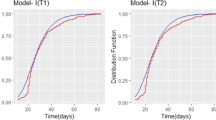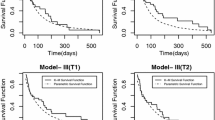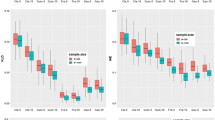Abstract
We propose bivariate Weibull regression model with heterogeneity (frailty or random effect) which is generated by Weibull distribution. We assume that the bivariate survival data follow bivariate Weibull of Hanagal (Econ Qual Control 19:83–90, 2004). There are some interesting situations like survival times in genetic epidemiology, dental implants of patients and twin births (both monozygotic and dizygotic) where genetic behavior (which is unknown and random) of patients follows a known frailty distribution. These are the situations which motivate to study this particular model. We propose two-stage maximum likelihood estimation for hierarchical likelihood in the proposed model. We present a small simulation study to compare these estimates with the true value of the parameters and it is observed that these estimates are very close to the true values of the parameters.
Similar content being viewed by others
References
Boneng YT (2001) Weibull frailty for modelling heterogeneity. PhD Thesis, University of Guelph
Breslow NE and Clayton DG (1993). Approximate inference in generalized linear models. J Am Stat Assoc 88: 9–23
Clayton DG (1978). A model for association in bivariate life tables and its applications to epidemiological studies of familial tendency in chronic disease incidence. Biometrika 65: 141–151
Corbeil RR and Searle SR (1976). Restricted maximum likelihood estimation of variance components in the mixed model. Technometrics 18: 31–38
Freund JE (1961). A bivariate extension of exponential distribution. J Am Stat Assoc 56: 971–977
Green PJ and Silverman BW (1994). Nonparametric regression and generalized linear models. A roughness penalty approach. Chapman and Hall, London
Hanagal DD (1992). Some inference results in bivariate exponential distributions based on censored samples. Commun Stat Theory Meth 21: 1273–1295
Hanagal DD (1992). Some inference results in modified Freund’s bivariate exponential distribution. Biometric J 34: 745–756
Hanagal DD (2004). Parametric bivariate regression analysis based on censored samples: A Weibull model. Econ Qual Control 19: 83–90
Hanagal DD (2005). A positive stable frailty regression model in bivariate survival data. J Indian Soc Probab Stat 9: 35–44
Hanagal DD (2006). Weibull extension of bivariate exponential regression model with gamma frailty for survival data. Econ Qual Control 21: 165–174
Hanagal DD (2009) Weibull extension of bivariate exponential regression model with different frailty distributions. Statistical Papers 50 (to appear)
Harville DA (1977). Maximum likelihood approaches to variance component estimation and related problems. J Am Stat Assoc 72: 320–340
Hastie T and Tibshirani R (1986). Generalized additive models. Stat Sci 1: 297–318
Henderson CR (1975). Best linear unbiased estimation and prediction under a selection model. Biometrics 31: 423–447
Hougaard P (1986). Survival models for heterogeneous populations derived from stable distributions. Biometrika 73: 387–396
Lee Y and Nelder JA (1996). Hierarchical generalized linear models. J R Stat Soc B 58: 619–678
Lu JC (1989). Weibull extensions of the Freund and Marshall-Olkin bivariate exponential models. IEEE Trans Reliabil 38: 615–619
McGilchrist CA (1993). REML estimation for survival models with frailty. Biometrics 49: 221–225
McGilcrist CA (1994). Estimation in generalized mixed models. J R Stat Soc B 56: 61–69
Marshall AW and Olkin I (1967). A multivariate exponential distribution. J Am Stat Assoc 62: 30–44
Robinson GK (1991). That BLUP is a good thing: the estimation of random effects. Stat Sci 6: 15–51
Schall R (1991). Estimation in generalized linear models with random effects. Biometrika 78: 719–727
Vaupel JW, Manton KG and Stallard E (1979). The impact of heterogeneity in individual frailty on the dynamics of mortality. Demography 16: 439–454
Author information
Authors and Affiliations
Corresponding author
Rights and permissions
About this article
Cite this article
Hanagal, D.D. Modeling heterogeneity for bivariate survival data by the Weibull distribution. Stat Papers 51, 947–958 (2010). https://doi.org/10.1007/s00362-008-0188-2
Received:
Revised:
Published:
Issue Date:
DOI: https://doi.org/10.1007/s00362-008-0188-2




